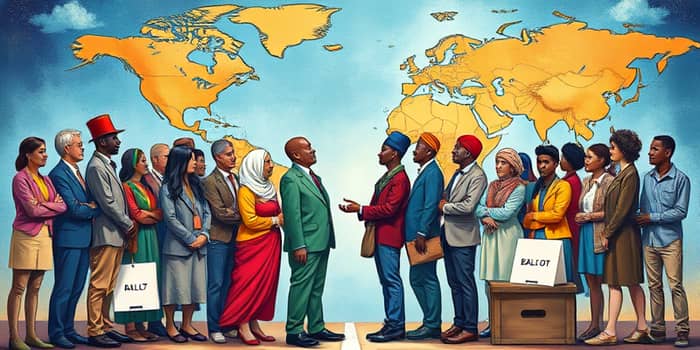
When ballots are counted and new administrations assume office, the repercussions extend far beyond national borders. Foreign aid budgets and priorities are especially vulnerable to the whims of electoral politics. As donor countries navigate changing leadership and shifting public sentiments, recipient nations grapple with unpredictable funding streams and evolving policy agendas.
Understanding these shifts is essential for governments, NGOs, and communities worldwide. By closely examining data trends, political influences, and coordination challenges, stakeholders can better prepare for a future where global cooperation depends on ever-changing domestic landscapes.
Recent statistics highlight a notable transformation: in fiscal year 2023, the U.S. allocated $71.9 billion on foreign assistance, representing about 1.2% of all federal expenditures. However, projections for fiscal year 2025 anticipate a reduction to roughly $58.4 billion, signaling a significant tightening of resources under current policy agendas.
On a broader scale, OECD Development Assistance Committee donors delivered $212.1 billion in official development assistance (ODA) in 2024, a 7.1% dip from the prior year. Humanitarian aid alone fell by 9.6% to $24.2 billion. This marks the first decline in ODA in five years, underscoring the reality of shrinking budgets amid burgeoning global crises.
These changes aren’t simply a matter of dollars and cents. They reflect deeper debates over national sovereignty, strategic interests, and the role of multilateral cooperation in a rapidly evolving world.
Scholarly research spanning more than half a century across 13 OECD countries reveals that party ideologies wield considerable influence over foreign assistance. Dynamic and evolving funding landscapes are shaped by electoral outcomes, with left-leaning administrations typically boosting aid by around 3.6% annually. These governments often prioritize comprehensive development and relief strategies, channeling funds toward the poorest nations, disaster response, and NGOs.
Conversely, right-leaning parties tend to raise aid budgets by a mere 0.3% per year. Their focus skews toward trade-related initiatives and migration control measures, frequently sidelining direct poverty alleviation efforts. Some far-right movements even advocate for severe cuts or complete elimination of foreign aid programs, citing domestic spending priorities.
The 2016 U.S. election widely exemplifies the power of politics over aid. The subsequent administration instituted a freeze on new development initiatives, sought to disband USAID, and withdrew from major multilateral agreements like the Paris climate accord and the World Health Organization.
One of the most contentious moves was reinstating the “global gag rule,” which restricts international NGOs receiving U.S. funds from offering or promoting abortion services. This policy shift alone disrupted programs in dozens of countries, forcing partners to scramble for alternative financing and upending healthcare networks.
Such abrupt policy swings illustrate how electoral mandates can generate sweeping humanitarian consequences, prompting beneficiary nations and organizations to constantly adapt their strategies and partnerships.
As major donors pull back, the humanitarian sector confronts a stark reality: rising global needs amid dwindling resources. Conflict zones, climate disasters, and health emergencies continue to mount, yet budgets for emergency relief and long-term development are under pressure.
In this context, resilient global partnership networks become indispensable. Smaller donors and regional coalitions are stepping up, but without strong coordination, efforts risk duplication or misalignment with on-the-ground realities. Donor agencies, UN bodies, and NGOs must forge mechanisms that pool resources, share data, and streamline responses to crises.
Innovations like joint funding platforms, real-time needs assessments, and multi-donor trust funds are emerging as models for efficient collaboration. Still, success hinges on political will—both from capitals that provide funding and from recipient governments that ensure transparency and effective implementation.
Looking ahead, the interplay between domestic politics and foreign aid is unlikely to diminish. As populist movements and national interest–driven narratives gain traction, policymakers must reconcile voter expectations with global responsibilities.
Some nations are already exploring comprehensive aid reforms to align programs with core values and strategic goals. Proposals include streamlining aid bureaucracy, enhancing accountability measures, and integrating development assistance with trade and security policies. These reforms seek to balance national interests and global welfare, emphasizing shared prosperity as a pillar of international stability.
At the same time, civil society and advocacy groups play a critical role in maintaining public awareness of humanitarian imperatives. By highlighting success stories and exposing the human cost of aid cuts, these voices can help sustain momentum for continued engagement.
Ultimately, the future of foreign assistance depends on forging a shared vision: one that acknowledges the primal need for flexibility amid electoral cycles, yet upholds the moral imperative to alleviate suffering and foster sustainable development. Through informed dialogue, strategic partnerships, and unwavering commitment, donor countries and recipients alike can navigate the complexities of politics and build a more resilient, equitable world.
References













